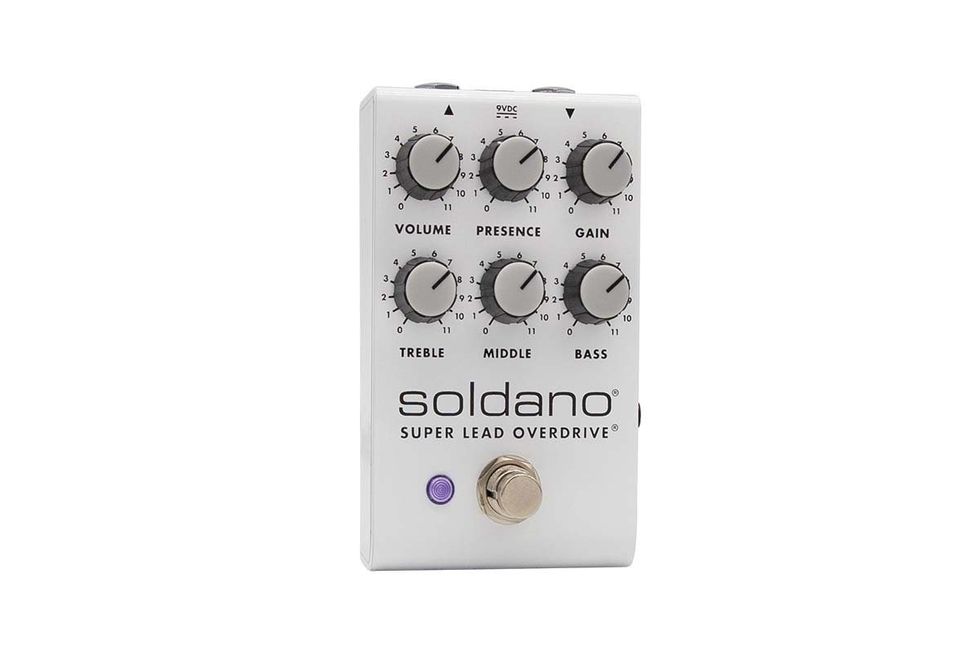In 1987, Mike Soldano created the SLO-100, a fire-breathing amp that, to this day, remains influential to those who build modern high-gain amps. Though the amp arrived at the peak of the hair-metal age, the SLO-100 appealed to players in many styles. Dokken’s George Lynch and Eddie Van Halen used it, but so did Mark Knopfler. That versatility is a big part of what made it iconic.
Decades later, the SLO-100 remains legendary. But at just south of $4,000 for a new one, they are not cheap. So, it’s cool that Soldano distilled so much of the essence of the SLO-100 into the SLO Pedal, a stompbox that sells for a mere $229. It’s a pretty nice stand-in for a player that doesn’t have the real deal on hand.
Streamlining Again
Several years back, Soldano released the Supercharger G.T.O., which essentially offered the preamp section of the SLO-100 in a pedal equipped with two 12AX7 tubes. I have an early edition of the Supercharger G.T.O., and it is, indeed, fantastic. It’s also pretty big. While it’s a very different stomp, the SLO Pedal is much more compact and practical in many respects. It’s built around a more straightforward, tubeless design. It also uses much of the gain section topology from the SLO-100.
While the SLO Pedal lacks the independent overdrive controls for preamp and master that you see on the SLO-100, Soldano users will recognize the 3-band EQ, presence control, and side-mounted deep switch, which stands in for the SLO-100’s depth knob and adds low-end oomph. It’s an easy-to-read and streamlined set of controls. And though it might look complex to a 3-knob-overdrive type of user, it’s easy to work with.
Hot-Rodded Hellraiser
When the SLO Pedal arrived on my doorstep, all the knobs were dialed to 7 (approximately 1:00 on a clock). Taking that as a lucky omen, I plugged it in, and right off the bat, without any adjustments, it sounded fantastic.
As much as I might have been inclined to play the SLO Pedal forever at lucky 7s, it offers many, many more tone-shaping possibilities. Just engaging the deep switch takes the edge off the highs and adds more body. Set this way, it almost walks the line between amp-style drive and woolly fuzz. When I adjusted the EQ to get a darker, creamier lead sound, I was pleasantly surprised at how easy it was to bring extra clarity in and out of the blend in precise amounts. Darker sounds also don’t seem to squash dynamic range in the way other drive pedals might. There’s less discernible compression and, even at a fairly dark setting, pick attack tends to cut through.
I was similarly impressed that the pedal didn’t squeal out of control at maximum-gain settings. It was also dead quiet when I muted the strings. In general, I probably wouldn’t use that level of saturation, but the way the SLO Pedal holds it together in that zone is impressive. There’s also a ton of clean headroom available. And even with the volume knob around 1 it was plenty loud.
SLO-Hand Stylings
Soldano amps were, of course, also used by very non-metal players, like Eric Clapton and Mike Landau, and the SLO Pedal shines in this context, too. With the gain rolled all the way off and the pedal volume cranked hard, the SLO Pedal delivers mid-gain sounds with a rich, overdriven amp feel. And though it might sound weird, I enjoyed the SLO Pedal’s lower gain sounds so much that, at times, I longed for even less than what I got at the minimum gain setting. I’m sure Soldano didn’t imagine this pedal as a boost. But with so much mid- to high-gain range, it’s hard to not imagine how a few cleaner sounds could make this a complete drive solution.
The Verdict
There are many other factors that give an amp its sound and feel, and Soldano nailed a lot of intangibles when they built the SLO-100 amp. But the way the SLO Pedal captures the personality of the SLO-100 is impressive. And even if you’re not specifically looking for the SLO-100 sound, the SLO Pedal can add a lot of that mid- to high-gain, with the headroom to get it across.












![Devon Eisenbarger [Katy Perry] Rig Rundown](https://www.premierguitar.com/media-library/youtube.jpg?id=61774583&width=1245&height=700&quality=70&coordinates=0%2C0%2C0%2C0)
















